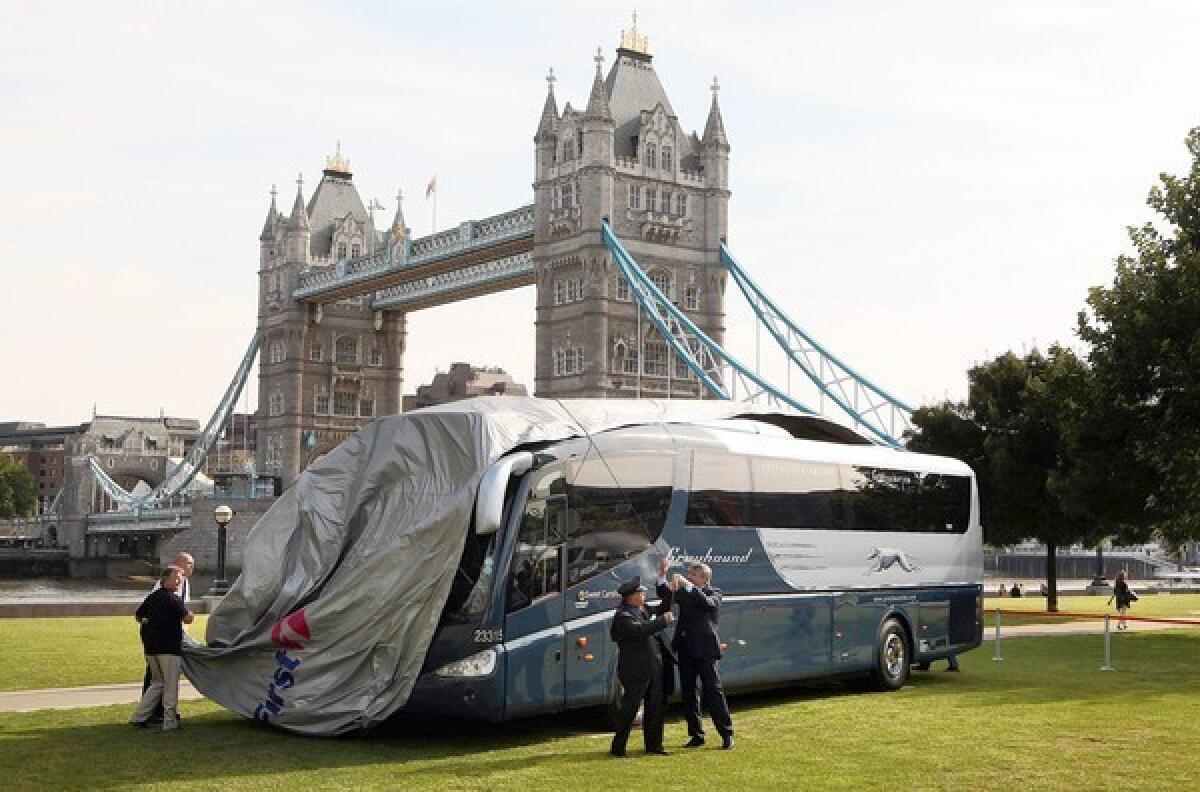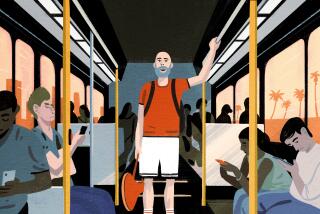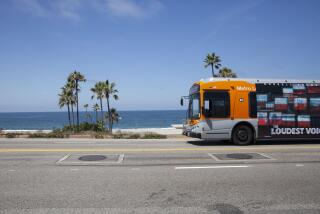Greyhound bus makes one of its last overnight trips across Britain

GLASGOW, Scotland — The other passengers aboard the late-night Greyhound bus weren’t looking to get their kicks on route M6. Mostly they were just hoping to catch some Z’s.
They settled in their seats, some of them sprawled across entire rows, drawing their coats over their heads and shutting out the rest of the world. Most of them would stay that way throughout the eight-hour ride from Glasgow to London, oblivious to their surroundings — and the fact that they were among the last to experience a bit of Americana transplanted to Britain.
The overnight journey is the only long-distance bus service operated by Greyhound in this country. It was launched last year to a mild flurry of publicity, but this weekend, it will make its final 400-mile run between Scotland’s and England’s most populous cities, the victim of weak demand and stiff competition.
As an American, I was curious as to how such a quintessentially American experience translated across the Atlantic — the call of the open road, the thrill of crossing unfamiliar territory, the anticipation over what, or who, lies ahead at the next stop or at the end of the line.
So, shelling out $38 for a one-way ticket, I climbed aboard the Long Tall Sally in downtown Glasgow (all of Greyhound’s buses in Britain sport female names from American songs), wondering what adventures would unwind before me along with the endless ribbon of asphalt.
There were just 10 passengers sprinkled throughout a bus that seated 45, a small but hardy band ready for an exciting road trip together.
Sure enough, nearly everyone’s face was aglow. But that turned out to be from the light of their smartphones and iPads as they texted friends or watched videos, lost in separate worlds. No one sat next to anyone else, or spoke a word — to each other, at least; one man carried on a loud conversation with someone on his cellphone.
With a shrug I gave in, checking my email for the umpteenth time and discreetly declining another generous offer of male enhancement.
Mindful of the 21st-century traveler, Greyhound’s British fleet provides electrical outlets for laptops and free onboard Wi-Fi, though 20-year-old Kara Thompson complained about the signal.
“It was awful. You’d get it for two minutes and then it’d drop,” said Thompson. A book of Sudoku and other puzzles lay next to her as backup.
She had come up to Scotland from her home near Portsmouth, one of the first destinations served by Greyhound from London when the company began its British operations in 2009. Greyhound now runs buses from London to a small number of nearby cities along the southern English coast; it also plies a route within Wales. But only the Glasgow-London service lasts more than a couple of hours.
For Thompson, choosing Greyhound over competitors had nothing to do with picking an iconic American brand or signing up for a particular experience.
“It was the cheapest one,” she said, acknowledging that she knew little about Greyhound.
From the moment the company entered the British market, there has been doubt about whether the Greyhound name or mystique would attract local travelers.
“America, the great big United States, is a road country.... That’s how the founding fathers got west,” said Irma Kurtz, a New Yorker who has lived in London for decades. “This is a seagoing country, because it’s a collection of islands. It’s also a rail country. There’s no romance to road travel in this country.”
Kurtz should know: In 1993, she published “The Great American Bus Ride,” an account of the three months, 10 days and four hours she spent crisscrossing the U.S. aboard Greyhound buses, an odyssey full of wide-open spaces, eccentric characters and bourbon. “I went through every state in the Continental Union,” said Kurtz. “I slept through Arkansas — it’s easily done.”
Slumber also quickly enveloped my Glasgow-London bus, which ruled out any effort to get to know my fellow passengers. Alcohol was forbidden. Cocooned in solitude and sobriety, we glided silently south, passing through or skirting regions of great natural beauty, such as the Lake District, though the inky blackness beyond our windows dashed hopes of gazing at the landscape in contemplation or boredom.
Except for a quick stop to pick up another passenger and a comfort break a few hours later, our journey was uninterrupted, which served the interests of time but sacrificed any pleasures from touching down in backwater towns, or even larger ones.
We rolled through Lockerbie, a quiet community now synonymous with Britain’s worst terrorist attack, the 1988 downing of a Pan Am airliner, which killed 270 people. We gave up on the chance to brag later of poking around places with names like Ecclefechan, Over Kellet, Whittle-le-Woods and Foulbridge.
In Charnock Richard, we spilled out of the bus to stretch our legs at a nondescript rest stop and suddenly found ourselves face to face with pure Americana: a Burger King outlet, a KFC counter and a cabinet of Krispy Kreme doughnuts. Yes, I nodded, this land is my land.
Niall Dowds, a spokesman for FirstGroup, the Scottish transport company that owns Greyhound (including its American operations), said that the discontinuation of the Glasgow-London line would not affect the shorter Greyhound services in southern England and Wales, which are performing well.
“It’s probably the world’s most famous bus brand,” Dowds said.
But to my fellow passengers, it was probably just a cheap way to get from A to B, not a window into American culture.
When Long Tall Sally finally pulled into London, they quickly clambered off, shouldered their bags and melted away into the still-dark morning, without a final look back at the long blue bus or the gleaming silver greyhound, at full stretch, stamped on its side.
More to Read
Sign up for Essential California
The most important California stories and recommendations in your inbox every morning.
You may occasionally receive promotional content from the Los Angeles Times.











